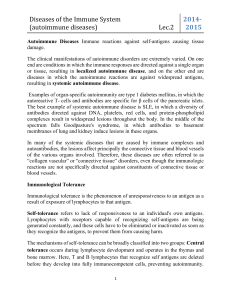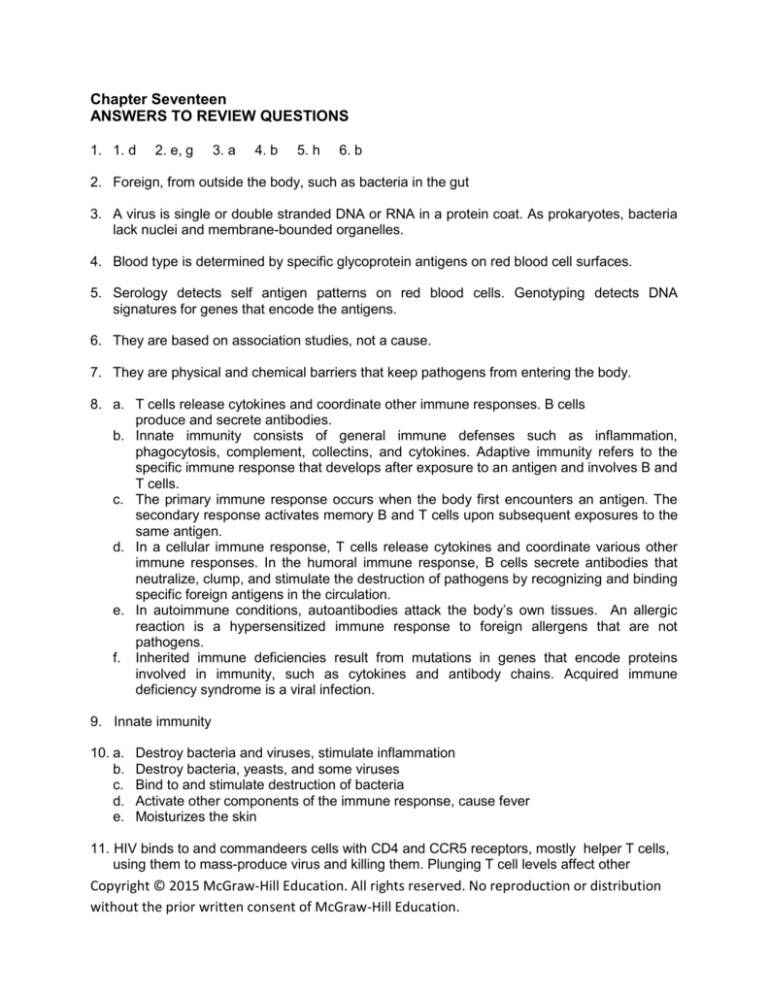
Chapter Seventeen
ANSWERS TO REVIEW QUESTIONS
1. 1. d
2. e, g
3. a
4. b
5. h
6. b
2. Foreign, from outside the body, such as bacteria in the gut
3. A virus is single or double stranded DNA or RNA in a protein coat. As prokaryotes, bacteria
lack nuclei and membrane-bounded organelles.
4. Blood type is determined by specific glycoprotein antigens on red blood cell surfaces.
5. Serology detects self antigen patterns on red blood cells. Genotyping detects DNA
signatures for genes that encode the antigens.
6. They are based on association studies, not a cause.
7. They are physical and chemical barriers that keep pathogens from entering the body.
8. a. T cells release cytokines and coordinate other immune responses. B cells
produce and secrete antibodies.
b. Innate immunity consists of general immune defenses such as inflammation,
phagocytosis, complement, collectins, and cytokines. Adaptive immunity refers to the
specific immune response that develops after exposure to an antigen and involves B and
T cells.
c. The primary immune response occurs when the body first encounters an antigen. The
secondary response activates memory B and T cells upon subsequent exposures to the
same antigen.
d. In a cellular immune response, T cells release cytokines and coordinate various other
immune responses. In the humoral immune response, B cells secrete antibodies that
neutralize, clump, and stimulate the destruction of pathogens by recognizing and binding
specific foreign antigens in the circulation.
e. In autoimmune conditions, autoantibodies attack the body’s own tissues. An allergic
reaction is a hypersensitized immune response to foreign allergens that are not
pathogens.
f. Inherited immune deficiencies result from mutations in genes that encode proteins
involved in immunity, such as cytokines and antibody chains. Acquired immune
deficiency syndrome is a viral infection.
9. Innate immunity
10. a.
b.
c.
d.
e.
Destroy bacteria and viruses, stimulate inflammation
Destroy bacteria, yeasts, and some viruses
Bind to and stimulate destruction of bacteria
Activate other components of the immune response, cause fever
Moisturizes the skin
11. HIV binds to and commandeers cells with CD4 and CCR5 receptors, mostly helper T cells,
using them to mass-produce virus and killing them. Plunging T cell levels affect other
Copyright © 2015 McGraw-Hill Education. All rights reserved. No reproduction or distribution
without the prior written consent of McGraw-Hill Education.
immune system cells, making the body susceptible to bacterial, viral, and other opportunistic
infections and cancer.
12. HIV mutates rapidly, replicates rapidly, the site where it binds to T cells is shielded, and
resistance alleles are very rare.
13. a.
b.
c.
d.
Collapse of entire immune system
Increase in viral infections and cancer
Increase in bacterial infections
Total collapse of immune system
14. Shuffling of gene segments in B cell development
15. In SCID, defective T and B cell function results in little to no immune response. In AIDS, HIV
infects helper T cells and reproduces, eventually killing enough T cells to overcome cellular
immunity. SCID is inherited; HIV/AIDS is an infection.
16. Allergens stimulate production of IgE antibodies that bind mast cells, causing them to
release allergy mediators. In an autoimmune disorder, antibodies attack the body's cells and
tissues.
17. Memory and plasma B cells respond specifically to one antigen following a cytokine cue
from a T cell. Plasma B cells secrete antigen-specific antibodies and are in the circulation for
only a few days. Memory B cells remain, providing a fast response the next time the antigen
is encountered.
18. T cells regulate B cell function as well as coordinate other immune responses.
19. X-inactivation and microchimerism
20. a. Transplanted bone marrow cells (the graft) recognize cells in the recipient (the host) as
foreign. The donor's cells attack the host's cells.
b. Defective T and B cell function results in little to no immune response.
c. An autoimmune condition stimulates overproduction of collagen, affecting skin and other
tissues.
d. In AIDS, HIV infects helper T cells and reproduces, eventually killing enough T cells to
overcome cellular immunity. Secondary invaders also infect during this HIV-induced
immunosuppression.
e. Allergens enter cracked skin, provoking dendritic cells to cause inflammation.
21. A polyclonal antibody response attacks a pathogen at several points simultaneously,
hastening recovery. MAbs are useful as diagnostic tools because of their specificity.
22. a.
b.
c.
d.
e.
Stimulates production of specific antibodies
Assists the immune response
Boosts cellular immunity
Blocks the receptor for the allergy mediator histamine
May stimulate a rejection reaction or graft-versus-host disease.
Copyright © 2015 McGraw-Hill Education. All rights reserved. No reproduction or distribution
without the prior written consent of McGraw-Hill Education.
23. A reverse vaccine is a vaccine in that it prevents an infectious disease, but it uses the
genetic instructions for antigens, rather than the protein antigens on pathogen surfaces.
24. Knowing the genome sequence of pathogens enables epidemiologists to trace who infects
whom in an outbreak by following mutations.
ANSWERS TO APPLIED QUESTIONS
1. Norovirus infection goes through a person so fast that antibodies are not made.
2. It is autoimmune, because of the presence of autoantibodies.
3. Dr. House and colleagues might test for levels and types of antibodies, presence of genetic
markers or infectious agents, and toxicology.
4. Antibiotics treat the bacterial infection, but not the inflammation in the joints, which is an
autoimmune response.
5. The primary immune response alerts the body to the first encounter with the virus. A rapid
secondary immune response occurs on subsequent exposure to the virus.
1. Colony stimulating factor.
2. Receive bone marrow cells from the donor or take immunosuppressant drugs or remove
antigens from the transplanted organ.
ANSWERS TO WEB ACTIVITIES
1. Answers vary with website visited. For reference check claims using the better business
bureau (http://www.bbb.org/) or the federal trade commission
(http://www.ftc.gov/bcp/conline/edcams/onlineshopping/) websites.
2. ClinicalTrials.gov Identifier NCT01129544 describes gene therapy for SCID-X1.
ClinicalTrials.gov Identifier NCT01078571 is a monoclonal antibody-based drug to treat
rheumatoid arthritis. ClinicalTrials.gov Identifier NCT01992172 is a topical treatment for
atopic dermatitis, an allergy.
ANSWERS TO CASE STUDIES AND RESEARCH RESULTS
1. a.
b.
c.
d.
allograft
isograft
xenograft
autograft
2. There will not be Rh incompatibility because the female would have to be Rh-
Copyright © 2015 McGraw-Hill Education. All rights reserved. No reproduction or distribution
without the prior written consent of McGraw-Hill Education.
and the male Rh+.
3. Sample the bacteria from several individuals and compare the genome sequences. Then
arrange the people so that the changes are stepwise.
4. a. autosomal dominant
b. An autoimmune response prevents interleukins from acting.
c. Autoimmunity indirectly increases the risk of infection by impairing the function of
cytokines that fight infection.
5. xenotransplant
Copyright © 2015 McGraw-Hill Education. All rights reserved. No reproduction or distribution
without the prior written consent of McGraw-Hill Education.





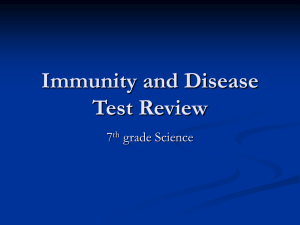
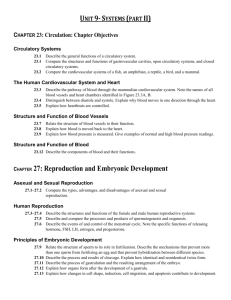
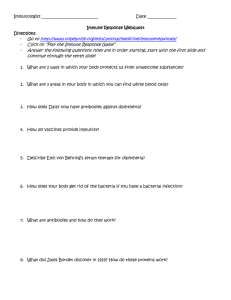
![Immune Sys Quiz[1] - kyoussef-mci](http://s3.studylib.net/store/data/006621981_1-02033c62cab9330a6e1312a8f53a74c4-300x300.png)

